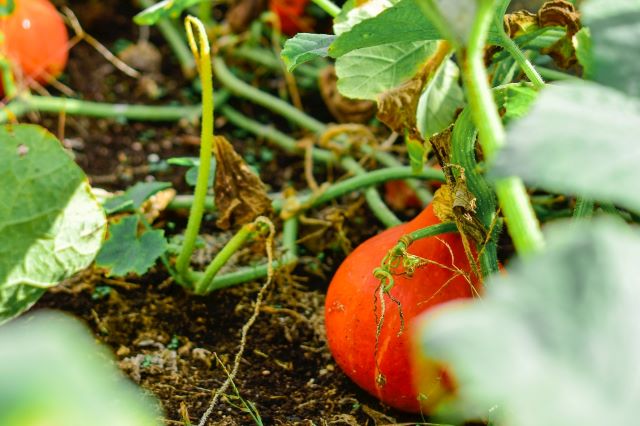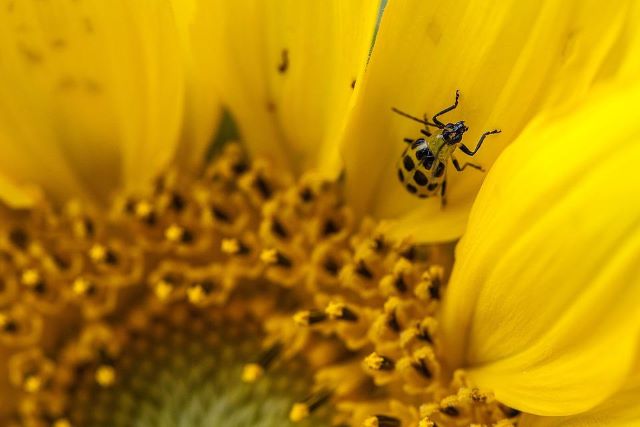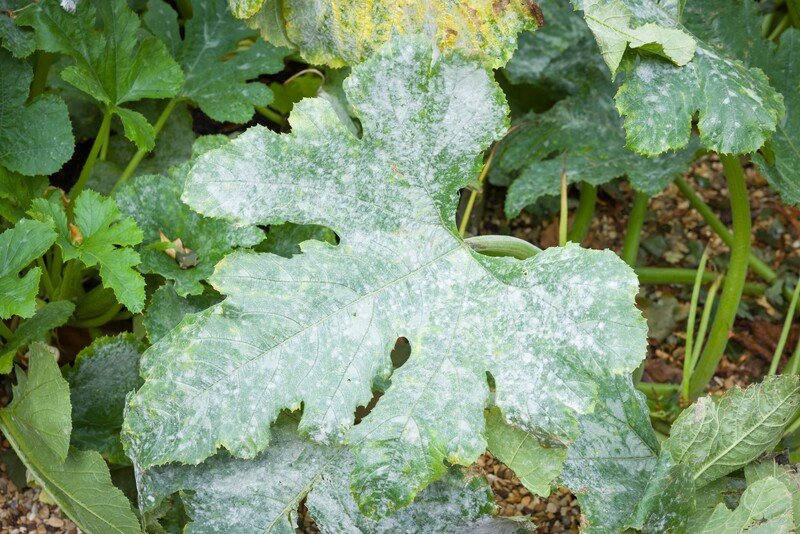We all want to grow the best pumpkins our home gardens can provide. So it’s disappointing if our pumpkins fall off of the vine prematurely or begin to rot and die. If like me, you have experienced dying pumpkins, you’re probably wondering what’s causing your pumpkins to die and how can you prevent this from happening. Read on to find out.

Table of Contents
Why Are My Pumpkins Dying?
The most common causes of dying pumpkins are pests, disease, incorrect watering, extreme weather conditions, nutrient deficiency, unbalanced soil pH, and competition for growing space.
Let’s take a look at each of these causes and find solutions so you can be harvesting an amazing crop for healthy pumpkins.
Related: Pumpkin Flowers But No Fruit? 8 Causes and Solutions | 9 Pumpkin Pests (And How To Get Rid Of Them!)
1. Pest Attack

Pumpkin plants and their fruits are a favorite snack for several insects, such as squash bugs, aphids, cucumber beetles, leafminers, and whiteflies. Pumpkin plants may drop their fruits prematurely in order to survive a pest attack. However, it is more likely for the fruits of the pumpkin plant (the “pumpkins”) turn yellow and die once they have been infested by pests.
Insecticides often kill bees, so it is not my first choice of action. However, if an insecticide must be used, it’s best to apply it in the early evening or once the pumpkin blossoms have closed for the evening.
Most pests have natural predators that prey on them in your garden; one of the most prolific predators of aphids is ladybugs. Introducing ladybugs to your garden will deter aphids, and possibly other pests, from destroying your pumpkin plants, and consequently, your pumpkins.
Besides beneficial insects, I like to use organic insecticidal soap or horticultural neem oil for getting rid of pest attacks on my pumpkins.
2. Pumpkin Plant Disease

There are many air and soil-borne diseases that can attack the foliage of pumpkin plants, often resulting in the death of the plant and its pumpkins.
The most common foliar diseases that occur on pumpkin plants are powdery mildew, downy mildew, gumstem blight, white speck, and anthracnose. These diseases are spread by pathogens in the soil or on pests, or the seeds of the plant may carry pathogens.
Fungal and bacterial diseases that attack the foliage and fruit of your pumpkin plants can be prevented by spraying fungicides on the plants’ stems and foliage. When spraying fungicide on the foliage of your plants, be sure to spray the undersides of the leaves too.
Weeds harbor insects (such as aphids) that may carry pathogens. Therefore, clearing your garden of any weeds is an effective measure in reducing the risk of diseases.
I prefer using a fungicide that contains copper, and spraying the fungicide using a pump spray bottle as it is the easiest way to cover all the necessary plant surfaces. But my first attempt to eradicate powdery mildew is to make my own natural fungicide using milk. You can read more here: Milk Spray Recipe For Powdery Mildew (Natural Fungicide for Plants)
3. Incorrect Watering of Pumpkin Plants
If the leaves of your pumpkin plants are beginning to fade in color and/ or are wilting, this may be an indication that there is a problem with the amounts of water that your plants are getting. Pumpkin plants prefer to grow in soil that is moist with excellent drainage.
The leaves of a pumpkin plant act as umbrellas (as they are so large) and prevent the soil under their canopy from drying out. However, if the leaves of the pumpkin plant are wilted and shrunken (possibly due to heat or disease) the soil will become too dry and the plant may die, along with the pumpkin fruit.
When there is too much water added to your soil, it becomes waterlogged and the roots of your plant remain wet. Poor drainage in the soil and excessive watering will cause the roots of your pumpkin plant to rot.
The dead roots of your pumpkin plant will not absorb any nutrients or water from the soil and without any of these essentials, your plant will fade in color and die.
The guide to use when watering your pumpkin plants is: between 1 to 1 and 1/2 inches of water per week. You can always check the moisture levels in your soil with a hydrometer tool, or gently place your finger under the first layer of soil to feel the dampness of the soil.
Mixing your soil with compost and sand, or planting your pumpkins in a raised garden bed will improve your soil’s drainage. Soil that has sufficient drainage will prevent the roots from being infected with a fatal root-rot disease.
When watering my pumpkin plants, I gently move the leaves of the plant aside and concentrate the watering on the soil and base of the plant (for the roots). This prevents the leaves from developing fungal diseases as they wont be constantly wet.
4. Extreme Weather Conditions

As a warm weather crop, pumpkins grow best in temperatures ranging from 68-94 °F (20-35 °C). However, should temperatures go beyond or below the threshold, they can wilt and die, or freeze. Frost is detrimental to pumpkin plants and their fruits as it causes injury to the vines.
Although the leaves of a pumpkin plant are hardy and resistant to some heat, they will require shade when temperatures persist above 100 °F (38 °C).
Depending on the variety of plant that is being grown, pumpkin plants should mature after 80 – 130 days. Planting your pumpkin plants during the correct season (usually early May to June in the Northern Hemisphere) will increase your harvest and decrease the possibility of your plants being affected by the weather.
During the warmer summer months, I enclose my pumpkin garden with a UV-resistant shade cloth that surrounds the border. I’ve found the shade cloth provides my pumpkin plants with some relief from the scorching sun, and it keeps my soil moist for longer.
5. Soil Nutrient Deficiency
Pumpkins are known to have a healthy appetite for nutrients and require a well-balanced diet. A lack of nutrients in the soil will cause the yellowing of leaves and possibly lead to the plant’s death.
As your pumpkin plant develops, it needs different nutrients to thrive; in the beginning of a pumpkin plant’s life cycle, it will need large amounts of nitrogen to support the growth of its green leaves.
When a pumpkin plant shows signs of flowering, it will require less nitrogen in the soil and more phosphorus and potassium. If you want to grow bright orange pumpkins, ensure that your plants are fed sufficient potassium and phosphorus when they are flowering.
However, before adding any nutrients to your soil, you will first need to know which types of nutrients it already contains. A soil testing kit will help you measure the nutrients and pH levels in your soil. Pumpkins prefer soil pH around 6-6.5.
Adding bone meal to your soil prior to planting your pumpkin seeds will give your plants the nutrients boost that they need. Bone meal will slowly release nitrogen into the soil, and has a high calcium and phosphate content.
I like to feed pumpkin plants an all-purpose organic fertilizer like this one as it caters to all their dietary requirements.
6. Unbalanced Soil pH
Pumpkins prefer to grow in soil that is slightly acidic, with their optimal soil pH being 6-6.5. If the pH levels in your soil are either too low or too high, your plant will not be able to absorb nutrients effectively.
With the help of a soil testing kit (mentioned above), you are able to measure the pH levels in your soil. You can lower the pH levels in your soil from a neutral 7.0 to a slightly more acidic 6.5 by increasing the nitrogen in the soil. Adding organic matter and compost will naturally decrease the pH level as it increases the levels of bacteria in the soil.
If your soil is too acidic and you need to increase the pH level, you can do this by adding limestone to your soil.
An effective technique that I use to lower the pH balance is to mix alfalfa powder in my soil. I’ve discovered that by sprinkling crushed eggshells and/ or potash from a wood fire increases the pH level in my soil.
7. Pumpkin Plants Competing For Space
The creeping vines of a pumpkin can stretch 50 square feet across a garden, so pumpkin plants need plenty of space. If pumpkins are planted too close to one another, they will starve each other of nutrients and water.
A crowded pumpkin garden will cause the fruits of your plants to drop off as they will attempt to conserve the available resources that they can salvage from the soil, and focus their energy on survival. In order to avoid an overcrowded garden, plant your pumpkin seeds at least 5 feet apart from each other.
Further reading:
